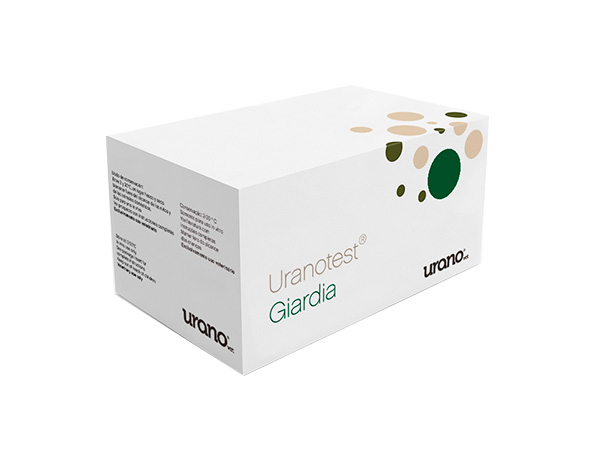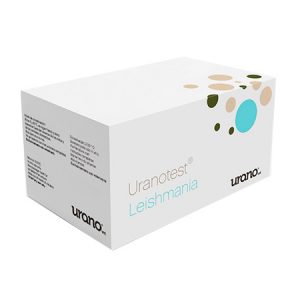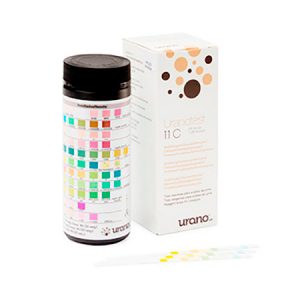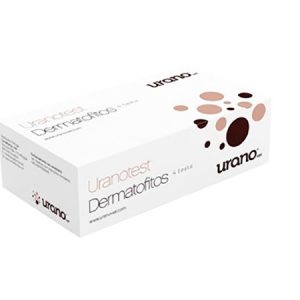Information for the veterinarian
Uranotest® Giardia: good diagnosis, the key to effective control and prevention.
Good diagnosis of Giardia involves spotting a series of clinical and laboratory signs.
Clinical signs:
- Anorexia, apathy.
- Vomiting.
- Gelatinous, watery, bad-smelling diarrhoea, accompanied by abdominal distension and flatulence.
- Also, persistent diarrhoea with steatorrhoea.
Laboratory signs:
- Detection of trophozoites in fresh faeces samples (many false negatives in low load infections)
- Detection of oocysts in faeces by microscope (the excretion of oocysts is intermittent, leading to many falses negatives)
- PCR (rather expensive and hard to access to include in health procedures)
- Immunodiagnostic techniques (immunofluorescence, ELISA, immunochromatography) to detect antigens in faeces, making it possible to detect infestations even when the number of oocysts excreted is low.
G. intestinalis (duodenalis or lamblia) exists everywhere and its prevalence is rising. In developed countries it is considered the most common intestinal parasite in both pets and human beings.
In dogs and cats, prevalence is believed to be over 50%, and this is much higher among young animals than adults, especially those from pet importers and breeders with poor sanitary standards.
Giardia intestinalis infects a very wide range of vertebrates, classified in genotypes A to G according to host-specificity. Genotypes A and B are generally considered zoonotic.
Despite its pathogenicity for pets and zoonotic potential there is little awareness on the part of pet owners (and even sometimes among veterinarians) of the importance to the health of pets and those around them of controlling Giardia and other internal parasites.
Owners are concerned that their dog should be vaccinated because it will be in contact with their family and children, but the most frequent zoonoses are caused by parasites like Giardia and Toxocara rather than the micro-organisms against which vaccines are generally administered.
Veterinarians do not usually have procedures in place for diagnosing Giardia, despite its high clinical prevalence and the importance of diag nosing it in order to prescribe specific treatment, A single dose of a wide-spectrum antiparasitic is not enough to treat and prevent this illness.
Moreover, it has been established that one of the most frequent reasons for vaccination failure is an incorrect deworming.
It seems beyond doubt that the prevention, diagnosis and control of Giardia are an essential part of preventive health procedures for both young animals and adults.
Uranotest Giardia, the tool the veterinarian needs for effective preventive treatment: recommended procedures.
URANOTEST® Giardia is a kit for detecting Giardia antigen in faeces that makes it possible to confirm or rule out the presence of this parasite in dog and cat faeces simply, cheaply, quickly and reliably. Its ease of use means it can be used in prevention and control procedures, either alone or with the Uranotest® Copro coprological diagnosis kit.
When should a Giardia test be carried out?*
- Puppies and kittens to be brought into the home from breeders or importers of doubtful reliability, including those with signs of diarrhoea.
- Dogs or cats with signs of diarrhoea compatible with Giardia infestation, regardless of its source.
- Pregnant female dogs and cats to avoid contagion of litter.
- Pets from animal shelters and adoption centres to be brought into the home (due to the high prevalence of Giardia in group animal accommodation)
- A test should be carried out before bringing a pet into the home if there are other animals or children there, due to the risk of contagion and their zoonotic potential.
*An alternative to carrying out a Giardia test is a Uranotest® Copro coprological test. This system has the advantage that, as well as Giardia, it can detect other parasites such as coccidia, nematodes, trematodes and so on. The disadvantage is that it is a more subjective method that depends on the observer’s experience. In the case of infestations with a low number of oocysts, it is hard to observe Giardia oocysts under the microscope if the observer lacks sufficient experience. The Uranotest Giardia test provides objective information that does not depend on the observer’s experience.
A good option is to carry out a coprological test with Uranotest® Copro. In the event that no Giardia oocysts are detected despite serious suspicion of infestation, the contents of the Uranotest® Copro vial can be used as a sample without needing to collect faeces again. The procedure is as follows:
1. Homogenise the contents of the Uranotest® Copro vial.
2. Take 8 drops of Greenfix® dilutant mixture + faeces and place them in the dilutant tube supplied with the Giardia kit.
3. Agitate gently to mix well and take 4 drops of the contents using the pipette supplied, and place them slowly, one by one, in the round test dish, following the instructions for the kit.
4. If the sample does not “migrate” this may be because you started with a Greenfix® + faeces sample containing too much faeces.
5. In case of doubt, contact the Urano Vet technical service. asistenciatecnica@uranovet.com




Reviews
There are no reviews yet.